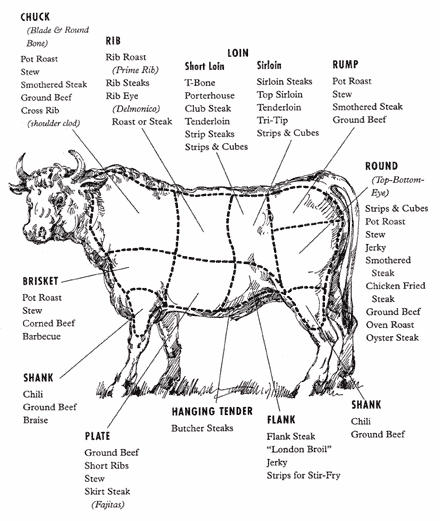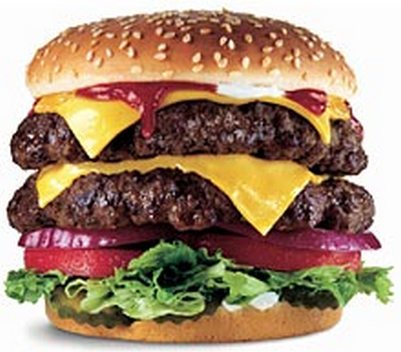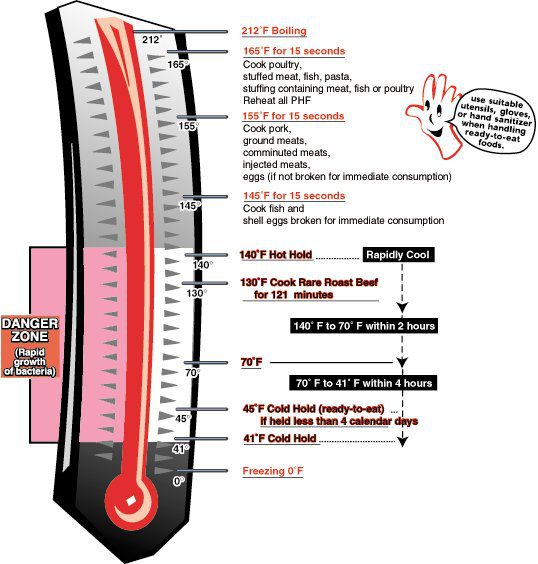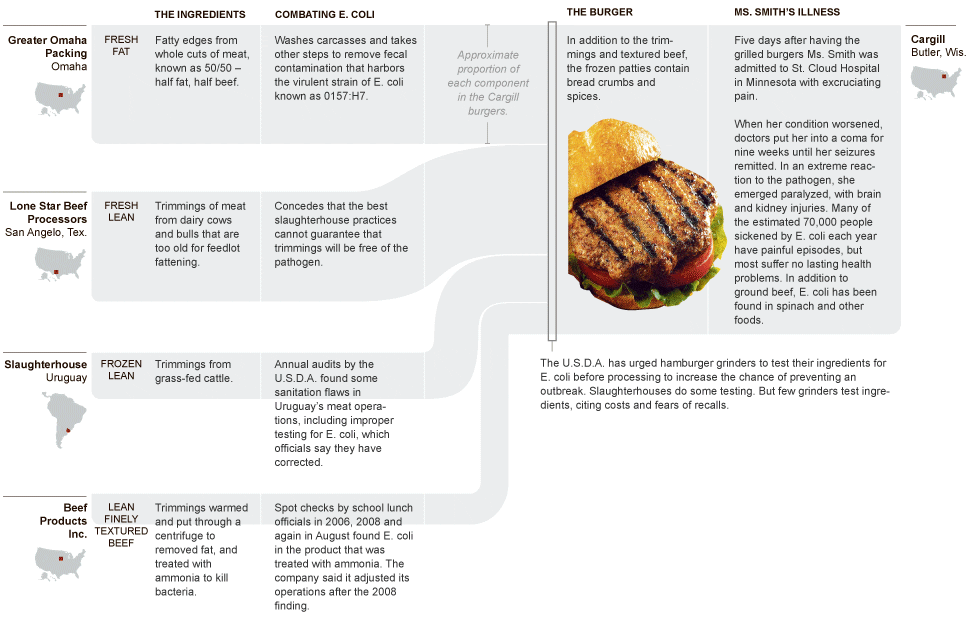What is meat?
Throughout history and across cultures, humans have eaten pretty much every living creature they could tackle or scavenge.
This includes creatures from giant mammoths and whales, to insects, grubs, and snails — and everything in between.
While generally speaking, any animal flesh could be considered “meat”, we typically use “meat” to refer to the flesh of mammals and birds.
Most of the meat we consume in North America is animals’ muscle tissue. Muscle tissue is made up of mostly water, protein and fat.
White meat is more fast-twitch muscle and red meat is more slow-twitch. The main determinant of color in meat is the concentration of myoglobin. There is a higher concentration of myoglobin and fat in the slow-twitch muscle. Nutritionally, if the meat is properly trimmed, the color makes minimal difference.

However, many cooks, particularly in non-North American cuisines, use the entire animal as much as possible. For example:
- Livers can be cooked straight or ground to produce dishes such as pates or terrines.
- Tripe (intestines) or stomach — think of Scottish haggis (stuffed sheep stomach) or Italian tripe soup
- Feet and other cartilaginous parts such as tails are often used to make gelatins and aspics; ox-tail soup is a popular Caribbean dish
- Bones can be boiled for nutrient-rich broth (the bone’s minerals, such as calcium, magnesium, and phosphorus, dissolve into the cooking liquid)
- Tongue
- Brains
- Sweetbreads, aka the thymus glands
- Heart, e.g. Peruvian anticuchos (kebabs)
- Kidneys, e.g. British steak-and-kidney meat pie
- Eyeballs
- Head: Sheep’s head is a local delicacy in Iceland; chicken head soup is common in East Asia
- Fat: Many chefs purposely render animal fat to use in cooking; pork, duck, and goose fat are particularly prized for their taste. The expression “schmaltz” actually refers to rendered fat that’s used as a spread for bread. Arctic people eat blubber from seals or whales.
- Skin, e.g. pork rinds or pork cracklings, which are deep-fried pork skins
- Blood, e.g. blood sausage or Thai dinuguan — the cattle herding Masai people in Kenya are well-known for subsisting on a diet chiefly of blood, meat, and milk
- And even the euphemistically named “Prairie oyster” or “Rocky Mountain oyster“, aka testicles
After cooking became known, meat consumption likely became more attractive and valuable, as the human body doesn’t digest and absorb high amounts of raw flesh efficiently. When we cook meat, protein is denatured and water is pressed out of the fibres.
Domesticated vs wild animals
Generally speaking, there are two kinds of animals from which we usually obtain meat – grazers and omnivores.
Grazers are herbivores that live on grass and other vegetation:
- ruminants with multi-chambered stomachs, such as cattle, sheep, buffalo, goats
- rodents such as rabbits
Omnivores include pigs and chickens, which can eat grass, kitchen scraps, pasture stubble and wild foods.
We don’t tend to eat many carnivores, though people do eat some, especially outside North America.
Out of the thousands of edible animal species, humans have only domesticated a few:
- poultry (chicken, geese, ducks, turkey, quail)
- cows, oxen
- pigs
- goats
- transport animals: horses and camels (yes, people do eat these)
- companion animals: dogs and cats (yes, people eat these too)
However, wild/game animals appear in many cuisines, e.g.:
- sea and forest birds: puffin (Iceland), pheasant, wild turkey, etc.
- wild ruminants: reindeer and caribou, moose, elk, deer, buffalo/bison, muskox
- marine mammals: whale (Arctic regions, Japan); seal (Arctic regions)
- rodents: groundhog, squirrel, rabbit, beaver
- amphibians: frogs (eaten as frog’s legs)
- reptiles: turtle, alligator, snakes, etc. (US South/Southwest and East Asia)
- peccaries and wild pig relatives: javelina, wild boar
- bear
- porcupine
- snails (eaten as escargots in French cuisine)
- insects (popular in Africa and East Asia)
Deli meat (lunch meat) is to meat as Captain Crunch is to corn. Both are highly processed versions of the original food and they make your gums bleed. Wait – it’s only Captain Crunch that hurts your gums.
Why is meat so important?
We currently eat about 200 pounds of meat per person per year in the U.S. (not including marine life).
Animals raised in healthy environments can supply nutrient-rich meat, which contains all amino acids and various micronutrients.
There aren’t many cultures who have thrived on a 100% meatless diet. Still, the healthiest patterns of eating throughout history have included mostly plants (more than 80%).
Meat consumption
We know that eating 200 pounds of meat per year is unnecessary for health.
Additionally, if we consume only grazing animals, we can’t sustain this level of consumption. We don’t have enough land, time, nor money.
There are various ethical and environmental reasons to limit meat consumption.
These include how/where the animal is raised, what it’s fed, how it’s killed, and if we can supply enough to feed 7 billion people (predicted world population in 2010).
Factory farming
Virtually all meat found at conventional supermarkets is from an AFO (animal feeding operation). AFOs are factory farms, with “factory” not “farms” being the operative word.
Factory farms have been around since the 1940s, made possible by the cheap surplus of corn and soy.
AFOs congregate animals, feed, waste, and production operations to a small area. AFOs are highly mechanized and supply meat year round for an inexpensive price.
While there are many distinct breeds and species of domesticated animals, AFOs use only a few.
Just as “monocrops” are large swaths of a single, standardized breed of plant, AFOs use only a single type of animal that has been genetically modified or bred to grow rapidly and produce the maximum amount of meat possible in a short time.
AFOs do not breed for flavor nor animal health.
In nature, animals exist for their own reasons, not just for our use. In AFOs, animals are brought into the world solely to be used for food.
Factory farmed meat is a four-time-loser. It’s:
- bad for us;
- bad for the planet;
- bad for the animal; and
- bad for the farmer.
For more on AFOs – see here.
What you should know about meat
Meat & health
Recently, we’ve heard that meat consumption is correlated with increased risk of many chronic diseases.
Yet humans evolved as omnivores. Is the meat we’ve been eating for thousands of years suddenly causing various diseases? Doubtful.
The health dangers of modern meat are likely due to two factors:
- How we currently raise animals for meat
- How much meat we consume
Diets can be healthy when including moderate amounts of meat from healthy sources. Yet, unlike plants, which we can’t live without, we don’t need meat to survive.
How much and what types of meat can we consume while keeping ourselves and the planet healthy?
Meat provides mainly fat, cholesterol and protein. For more on how these influence health, see All About Fat, All About Cholesterol and All About Protein.
Since substances are concentrated in tissues, whatever the animal eats is what you’re eating, including medications. Since domesticated animals are fed largely corn (instead of the diets they evolved to eat), they are often ill.
Also, the grain-based diet means that domesticated animals’ meat is high in omega-6s, which are pro-inflammatory. Game and wild-type meats have a much healthier fatty acid profile, because wild animals consume vegetation and small animals (e.g. insects, worms) that are high in anti-inflammatory omega-3s. Pasture-raised animals (e.g. grass-fed cows) are healthier, and healthier to eat.
A meat-cancer connection has been reported in over 100 epidemiological studies from numerous countries with assorted food habits.
We don’t know if it’s a specific type of fat or protein causing the cancer, and/or whether meat intake actually signifies other things (such as low plant food intake). The core meat habits linked to cancer include:
- Eating red meat more than once a week
- Eating grilled meat more than twice a week
- Eating processed meats
HCAs and PAHs are mutagenic and carcinogenic chemicals created when meat is cooked at high temperatures (e.g., grilling, broiling and pan-frying). Boiling, steaming, poaching and stewing don’t generate these harmful compounds.
Meat and human evolution
Humans have some characteristics of carnivores and some of herbivores. I guess this means we’re equipped to eat omnivorously.
Some anthropological evidence suggests that our early “hunting and gathering” days were really more like “scavenging and gathering… and then if we were really lucky with a rock, hunting a small animal”.
Thus, our ability to consume all kinds of foods contributed to our evolutionary survival. Hard to be a picky eater in the forest or savannah.
Features that suggest we evolved to consume meat include:
- Teeth & jaws (can both tear/rip and crush)
- GI tract structure (shorter, no chambered stomachs for vegetation fermentation)
- Digestive enzymes and stomach acidity
- Ability to dispose of dietary cholesterol
- Location of reproductive organs
- Amount of food we can consume in one sitting
- Ability to injure and kill animals
Based on those factors, we appear to be able to eat both plants and animals, with an emphasis on plants.
Compared to carnivores, we aren’t expert hunters (we’re comparatively slow and weak; our senses are not very keen; and without a pointy stick, we’re not very tough); we don’t have innate blood lust (well, given human history, that point is debatable); we can’t consume high quantities of meat at one time (Las Vegas buffets notwithstanding); we’re prone to bacterial illness; we prefer cooked meats; we accumulate dietary cholesterol in the body; and we have the desire to consume sodium. (See AA Sodium for more.)

For more on carnivores vs. herbivores vs. omnivores, see the following:
- Humans Are Omnivores
- Contrary Facts vs Vegan Dogma: Facing the Honesty Problem
- Video – Are Humans Designed To Eat Meat?
Meat & food safety
Food safety is another health concern. Proper care is essential when handling meat.
Factory-farmed meat in particular contains high counts of salmonella, E.coli and other types of bacteria, which are often antibiotic-resistant. Processed meats may also contain deadly listeria bacteria.
Do not mix raw meat with other foods (e.g. raw vegetables); keep them separate in grocery bags and refrigerator.
Keep meats either cold or hot; ideally, cook them thoroughly. It’s OK to cook steaks to rare, as the bacteria are on the outside; however, ground meat and poultry must be cooked throughout the entire cut of meat.

In the U.S., salmonella poisons about 40,000 people each year and kills about 700. 15% of all chickens are infected with salmonella and more than half are infected with campylobacter.
A drug resistant strain of MRSA has been found in U.S. pigs. It’s traced to AFOs and the high use of antibiotics. MRSA kills more people than AIDS every year in the U.S.
73,000 Americans are sickened each year from foods contaminated with E. coli. Another 61 die from it. E. coli is most common in raw and undercooked meats.
A single portion of ground meat is often a fusion of various meats from different parts of cows and even from different slaughterhouses.
In 1986, Great Britain had the first cow diagnosed with mad cow disease. This is likely due to animals being fed other animals. Feeding rendered animals and wastes to other animals is still legal in the U.S. Since the first case of mad cow disease, variant Creutzfeldt-Jakob disease has been found to be caused by eating infected beef.
And do you remember all of the recalled spinach and tomatoes? You can thank AFO manure lagoons for that.
Meat & the environment
It’s natural, even healthy, for animals to graze on grasslands, ultimately delivering waste back to the soil. Some farmers can even balance the land to animal ratios. That’s the good news.
The bad news is that this situation only occurs when animals are scattered into the entire ecosystem. Mother Nature is great at this. Modern humans? Not so much.
With our current situation of overpopulation and efforts to feed billions, we now have severely degraded land and water.
Scale is everything when it comes to raising animals for nearly 7 billion people. The pasture-raised approach for meat production is currently unable to replace the conventional meat quantities consumed by the developed world.
In other words, though pasture-raising meat is a good solution for food quality, we can’t use it to generate the massive quantities of meat demanded by consumers and the fast food industry.
Consider the following:
- Bringing a cow to market weight on range-land alone requires each animal to spend several years foraging, rather than 6 months on a factory farm. This damages ecosystems (maybe we could replace all of the land dominated by subsidized corn and soy with ranges for animals — still not the most efficient, but better).
- Grass-fed cattle produce 4 times more methane than feedlot cattle.
- Producing one pound of grass-fed beef requires about 1,020 gallons of water. Producing one pound of factory farmed beef requires about 2,500 gallons of water. Apples, carrots and potatoes require about 50 gallons per pound.
- America is currently trampled by 20 million beef cattle degrading 2 million square kilometers of federal land. The 100,000 ranchers who lease these lands pay less than 1/3 of the land’s market value.
- If the world’s growing population decided to eat the same amount of meat that the world’s affluent now consume, we would need 67% more land than the earth has.
- 2 feedlots outside of Greeley, CO together produce more excrement than the cities of Atlanta, Boston, Denver and St. Louis combined.
When we return farm animals to natural living conditions, they’ll come across the same backwoods problems that led farmers to round them into feedlots in the first place. Data indicate that free-range pigs have 5 times as much Toxoplasma gondii, more salmonella, and even some Trichinella spiralis. Wasn’t Trichinella abolished?
Grass-fed choices seem to be more sustainable than the alternatives. Still, the environmental consequences are harsh enough for us to acknowledge that we may need to re-evaluate our total intake.
From an environmental perspective, eating meat a few times per month makes the most sense, which translates into about 12 pounds per year.
“Every environmental problem related to contemporary agriculture that I’ve investigated ends up having its deepest roots in meat production… Monocropping, excessive applications of nitrogen fertilizer, addiction to insecticides, rainforest depletion, land degradation, topsoil runoff, and declining water supplies… [I]f we continue to eat meat at current rates, there’s simply no way to achieve truly sustainable food production.”
– James McWilliams, author of Just Food
For more on environmental eating, see:
Meat & medications
Antibiotics are used to kill or inhibit bacterial growth. 70% of the antibiotics used in the U.S. are for animals we eat.
Cram a bunch of living organisms in close quarters and you’re gonna have problems. Doesn’t matter if its cows, chickens or kids – I’m thinking germs and disease.
From a WHO study:
“There is clear evidence of the human health consequences from agricultural use of antibiotics, including infections that would not have otherwise occurred, increased frequency of treatment failures (in some cases death) and increased severity of infections.”
The meat industry isn’t very excited about getting rid of antibiotics. Understandably so. Meat producers want to produce lots of meat, that isn’t diseased, tastes good, and is affordable to everyone. That’s tough without meds.
Still, antibiotic-resistant infections add $50 billion to the annual cost of American health care.
Steroids and growth hormones are sometimes used on animals to accelerate growth. These hormones are generally found in meat from AFOs and have been linked to various diseases.
Before flexitarians start doing the “I told you so” dance, if we swap out the steak for a squash, we are still consuming about 50 toxic chemicals (both organic and conventional), mostly natural pesticides occurring both in the food and as a residue on it.
Meat & money
Are you a tax-paying citizen? Well, I have bad news.
We pay $123 million in taxes each year to cover costs of grazing livestock. This means you’re automatically forced to condone soil erosion, the killing of wild animals that threaten livestock, and damage to water supplies. Even worse is that a majority of this meat is going to fast food restaurants.
Thanks to subsidies (paid by you and me), it costs ranchers just $1.61 to feed each cow. That’s less that it costs to feed a cat. Without price supports, the market cost for grazing on private land is about $10 per cow.
Subsidies and economies of scale have made grain and everything it is made of – including the animals that eat it – increasingly cheap.
If we ever want to make real change in how meat is produced in this country, eliminating subsidies and internalizing external costs is step #1.
Disadvantaged countries are incapable of exporting their products since they can’t compete with locally subsidized corn and soy. So they grow other crops unsuited for the environment. This leads to a dependence on fertilizers, pesticides and irrigated water.
Meat & spirituality
With all religions, eating meat depends on how each adherent interprets the teachings.
Buddhists and Hindus generally avoid meat since they practice ahimsa (non-violence). They usually abide by karma too. However, because Tibetan cuisine is typically meat-heavy and vegetables not very available, many Buddhists in Tibet remain meat eaters.
Followers of yoga claim that eating meat creates sloth, ignorance and darkness.
Certain meats like pork and meats containing blood are prohibited among Islamic followers. Along with the Jewish faith, Islam requires that animals be slaughtered in the most humane way, and animals may not be abused or unfairly constrained.
For those of Jewish faith, avoiding meat makes it easier to observe the laws of kashrut.
When considering the underlying mission of Christianity, which is stewardship and care, humans appear to have a duty to care for living creatures and the environment. This can be interpreted to mean that people who eat meat should seek ethically raised animals, and consider the ecological impact of their choices.
Summary and recommendations
“The meat industry depends on our ignorance to conduct its everyday business.”
– Susan Bourette, author of Meat: A Love Story
Most everyone disagrees with environmental degradation, animal cruelty and poor health. Our meat choices deeply influence all of the above.
The more plants displaced by meat in ones diet means a greater likelihood of illness down the road. Consuming no more than a few ounces of meat per day (about 60 pounds per year), from grass-fed/free-range/organic sources is your best option.
To get serious about changing the environment with our diets, one of the most productive things we can do is reduce meat consumption. Food grown on the factory model is costly — directly in the form of inputs, and indirectly in the long term erosion of our planet.
Learn where your meat is coming from and how it is raised.
Meat buying lingo
Grass-fed – Nothing to do with organic standards. Applies to ruminants – cattle, sheep, goats, and game. It means the animals were raised on grass and hay, but we don’t know exactly how much. If grass-fed beef isn’t also labeled organic, the grasses in which the animals roamed were likely sprayed with synthetic fertilizer and insecticides.
Grain-finished – The animal was raised on grass, then fattened with grain.
Pastured – Nothing to do with organic standards. Applies only to pork and poultry. It means the animals were allowed outside to consume vegetation and whatever else they wanted.
Vegetarian fed – The animals weren’t fed other animals. The animal never went outside (if it did, it might have consumed another animal).
Free-range –Nothing to do with grass-fed. It means the bird wasn’t in a cage. But it may have been in a barn.
Organic – Nothing to do with grass-fed or pastured standards. Organic animals eat organic grains and their access to pasture is usually minimal. For more on organic, see All About Organic.
Natural – Nothing to do with the animal’s diet. All fresh meat qualifies as natural – which doesn’t mean much. Current policy states that the term “natural” may be used in the labeling of meat products provided that the product does not contain any artificial flavouring, coloring ingredients, chemical preservatives, or any other artificial or synthetic ingredient and that the product is not more than minimally processed. It doesn’t indicate grass-fed, pasture raised, free-range or organic.
USDA Prime – For meat to receive this label, it’s gotta be fatty.
How can you be sure that the meat you get is ethically raised? One of the best ways is to get to know your farmer.
Supporting small farms ensures that you get good-quality meat, and small, family-based producers can make a living. The meat quality will be better, and you’ll often be able to get heritage breeds that taste better. Plus, you can ask the farmer directly about how s/he raises the animals.
Many regions offer Community Supported Agriculture (CSA) programs that include meat (as well as things like eggs and honey). For example:
- Chestnut Farms and Stillman’s Farm (Massachusetts)
- Twin Creeks and Stoddart Family Farms (Southern Ontario)
- Equiterre directory (Quebec)
To find a CSA near you, Google “meat CSA” and your area. In the US, try the CSA listings and LocalHarvest’s farm map.
Many game animals are now also raised on farms, though they cannot be factory farmed because of the nature of game animals (which is a good thing). If your tastes run to things like venison, bison, elk, and ostrich, you can often find small farms producing these as well.
For extra credit
- Grain fed meat has fewer vitamins, minerals and healthy fats. Feeding grain to grazers creates a dangerous environment in the animals’ bodies.
- If meat is immediately frozen, the proteins can bunch together, making it tough. Aged meat is more tender, since the enzymes are able to break down overlapping proteins.
- Some anthropologists have suggested that the custom of praying before a meal is an effort to appease the angry spirit of the sacrificed beast.
- Meat was once a secondary food – behind brain, tongue and marrow.
- “Rabbit starvation” occurs with consumption of over-lean meats and insufficient dietary fat.
- The quickest way to significantly diminish wasteful fertilizer applications would be to stop producing grain to feed livestock.
- The food found in the tomb from the Second Dynasty (between 2890 and 2686 BC) included cooked quail, kidneys, pigeon stew, fish and beef ribs.
- If one could wave a magic wand and radically reduce meat consumption, all discussions of fertilizer abuse would come to an abrupt halt.
- Many hunters argue that hunting is much more environmentally friendly than farming.
- Recently, scientists have offered a potential way to grow meat in the lab.
“We got too much food in America; too, much, food. People are starving all over the world, what do you mean red meat will kill you? No, no, no… don’t eat no red meat? No, don’t eat no green meat!”
–Chris Rock
References
Click here to view the information sources referenced in this article.
Learn more
Want to get in the best shape of your life, and stay that way for good? Check out the following 5-day body transformation courses.
The best part? They're totally free.
To check out the free courses, just click one of the links below.





Share